| ||||
|
Between 30 and 100 days after a child is born, the parents, siblings, and grandparents visit a shrine together to report the child's birth. The baby is dressed in a white under-kimono. On top of that kimono, the baby wears a brightly colored yuzen-dyed kimono if it is a girl, and a black kimono decorated with the family crest if it is a boy.
At the age of 20, young people celebrate their passage into adulthood by visiting a shrine on Coming-of-Age Day, the second Monday in January. For this occasion, girls wear furisode (kimonos with long flowing sleeves) and boys wear haori (half-coats) and hakama decorated with their family crests. Furisode kimonos are worn only by unmarried women. Once upon a time, young Japanese women declared their love for a man by fluttering the long-flapped sleeves of their furisode kimono. At weddings, the bride wears a pure white kimono known as a shiromuku. The color white signifies the beginning of a journey.
|
||||
|
Photos (from top): Children wear kimonos for the Shichi-Go-San Festival (courtesy of Hisako Nakatani ); a furisode kimono, worn only by unmarrid women (© Yoshiaki Yamamoto); Many women wear kimonos for their first visit to a temple or shrine in the new year.(courtesy of Hisako Nakatani) |
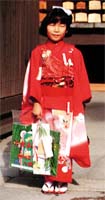 Japanese
people are keenly aware of the four seasons, and the clothes they wear
are always in keeping with the season. The Japanese are also very tuned
in to the stages of their lives. Special events are held to mark milestones
in children's growth, for instance, and people change their kimonos
to fit both the season and the occasion.
Japanese
people are keenly aware of the four seasons, and the clothes they wear
are always in keeping with the season. The Japanese are also very tuned
in to the stages of their lives. Special events are held to mark milestones
in children's growth, for instance, and people change their kimonos
to fit both the season and the occasion.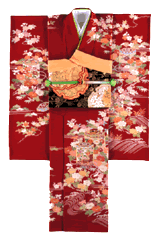 Another
key event in a kid's life is the
Another
key event in a kid's life is the 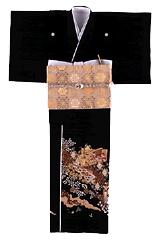
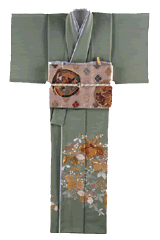
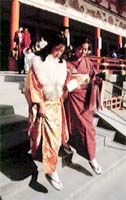 Once
a woman is married, she no longer wears a furisode. Instead,
she wears a tomesode, a kimono with shorter flaps on the sleeves.
The tomesode can be either black or another color. Black tomesode
with the wearer's family crest on them are reserved for formal occasions,
such as the weddings of one's relatives. Colored tomesode can
also be worn on formal occasions, but they do not always have the family
crest on them. A key distinguishing feature of tomesode (both
black and other colors) is that only the fabric on the bottom half of
the kimono is decorated with a pattern.
Once
a woman is married, she no longer wears a furisode. Instead,
she wears a tomesode, a kimono with shorter flaps on the sleeves.
The tomesode can be either black or another color. Black tomesode
with the wearer's family crest on them are reserved for formal occasions,
such as the weddings of one's relatives. Colored tomesode can
also be worn on formal occasions, but they do not always have the family
crest on them. A key distinguishing feature of tomesode (both
black and other colors) is that only the fabric on the bottom half of
the kimono is decorated with a pattern.